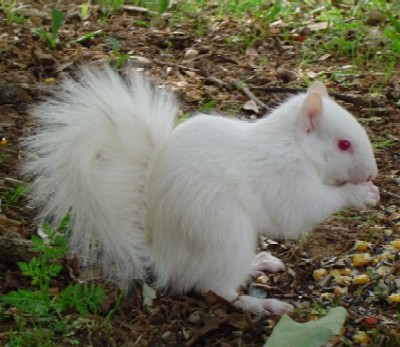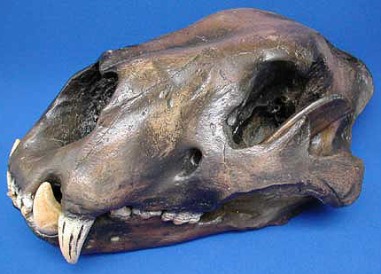
November 30, 2006

The Once And Future University of North Texas White Squirrel.
(This posting today is done in conjunction with my two end-of-2006 lists on white and black squirrels).
Portland, Maine, is the new city on Frommer’s list of the top world destination in 2007, as I mentioned yesterday. Now it turns out, the city has a new attraction – recent sightings of one lone white squirrel in its Longfellow Woods. (Nothing online about it yet.) This got me to pondering the question: Why do people think such an event is cryptozoological? Well, of course, it is not, but then why mention it here? First of all, I need a break from the heavy-duty debate going on about the Patterson-Gimlin footage, but there’s more.
Cryptozoology concerns itself with the study of as-yet-unverified, possibly soon-to-be-discovered species, literally “hidden animals.” But cryptozoology is not about lots of animal stories that seem extremely popular these days, such as ones on ligers (the hybrid crosses between lions and tigers), tigons (tiger x lion) or black (melanistic or near-melanistic) squirrels, and white (albino or near albino) squirrels.
Of course, that doesn’t stop the media from asking me about these animals while calling them “cryptids,” or you finding entries on MySpace.com labeling such things as “biology/cryptozoology.” They are, after all, anomalies in natural history and I am interested in those.
Bernard Heuvelmans kept his surveys of hybrids active and alive, and I commented once in a Fortean Studies article about his research on hybrids and their interest to cryptozoology.
A study of the hybridized offspring of known species is an important side interest of cryptozoologists because we need to be aware of when these animals appear and where. We don’t want to be chasing a supposed new species if there’s a chance it is merely a hybrid that’s developing naturally in a certain area.
Most hybrids, needless to say, are the forced products of humans manipulating captive species, the liger and tigon being good examples. A few are not.
One underlying theory about the Bili Ape was they were the result of crossbreeding between gorillas and chimpanzees. As it developed, they appear to be a subspecies of chimpanzee, but you often see the “hybrid” notion coming into ongoing investigations.
Despite DNA realities, bizarre stories, like the one on the “Maine Mutant,” demonstrate in their very names the underlying role that “hybrid theory” plays. Others, such as the off-based notion that Oliver is a human-ape hybrid, live on long after DNA samples prove something more mundane – like animal abuse – occurred to force this chimp to walk upright.
However, rarely, it does turn out that a new hybrid might be involved in an animal mystery, as for example, in the case of the “Pizzly, Grolar, or Polargrizz.”.
Color phases are another kettle of fish, altogether.
Take, for example, my interest in white squirrels and black squirrels. In a cryptoworld full of reports of cryptids that seem to be examples of new species, sometimes the sightings appear to be only be of melanistic, albino, and piebald animals. So, yes, I tend to follow reports of known species that appear and create breeding populations of “black,” “white,” and “splotchy” animals.
Why?

What if the reports of so-called “black panthers” in America turn out to only be mountain lions in bad lighting or escaped breeding populations of melanistic leopards in, for example, Appalachia or the Ozarks? What if there are pockets of undiscovered melanistic mountain lions, the real panthers of the American woods? Or what if there are gender-aligned melanistic populations of American lion (Panthers atrox) surviving from the Pleistocene?

In the 1970s, I did a survey of all of the known melanistic examples of felids in captivity. I was tracking any patterns that might had developed. Other than finding a few surprises such as melanistic bobcats and other medium-sized cats, I didn’t turn up a black puma in a zoo, although I did come across stillborn melanistic tigers. I think the most remarkable discovery I made in doing that research was that in zoos, at least, there is evidence of a large number of felid species that are melanistic from the mountains of Kenya. No wonder there’s reports of black lions and spotted lions from Kenya; they actually do seem to have an unusual gene pool concentration there.
In the realm of Bigfoot studies or more correctly hominology, color phase differences might be at the root of some incorrect speculation of divisions into various species or subspecies.
Why is a piebald appearance, and in some cases near albino descriptions, found among unknown hominoids mainly in two locations (1) in Siberia, i.e. northeastern Asia, and (2) northeastern North America, especially in the upper tier of states of the USA and lower tier of provinces of Canada, in the East?

Mapping out color phrases is an interesting exercise in visually searching for patterns. Listing the North American population of white and black squirrels, for example, is an intriguing exercise, as you can see in my two lists of the top spots to see white and black squirrels today.
About Loren Coleman
Loren Coleman is one of the world’s leading cryptozoologists, some say “the” leading living cryptozoologist. Certainly, he is acknowledged as the current living American researcher and writer who has most popularized cryptozoology in the late 20th and early 21st centuries.
Starting his fieldwork and investigations in 1960, after traveling and trekking extensively in pursuit of cryptozoological mysteries, Coleman began writing to share his experiences in 1969. An honorary member of Ivan T. Sanderson’s Society for the Investigation of the Unexplained in the 1970s, Coleman has been bestowed with similar honorary memberships of the North Idaho College Cryptozoology Club in 1983, and in subsequent years, that of the British Columbia Scientific Cryptozoology Club, CryptoSafari International, and other international organizations. He was also a Life Member and Benefactor of the International Society of Cryptozoology (now-defunct).
Loren Coleman’s daily blog, as a member of the Cryptomundo Team, served as an ongoing avenue of communication for the ever-growing body of cryptozoo news from 2005 through 2013. He returned as an infrequent contributor beginning Halloween week of 2015.
Coleman is the founder in 2003, and current director of the International Cryptozoology Museum in Portland, Maine.
Filed under Breaking News, Cryptomundo Exclusive, Cryptotourism, CryptoZoo News, Cryptozoologists, Cryptozoology